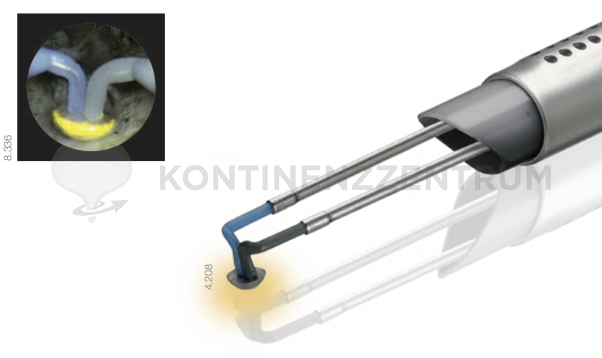Transurethral Incision of the Prostate (TUIP)
Surgical Incision of a Slightly Enlarged Prostate
Even a slightly enlarged prostate can restrict the outflow from the bladder and cause the typical symptoms of benign prostatic hyperplasia (BPH).
Treatment is usually initially conservative with medication, for example alpha blockers. If these medications are not sufficiently effective for benign prostate enlargement or are not tolerated by the patient, a surgical incision of the prostate (transurethral incision of the prostate, TUIP) can be performed. The procedure is also known as a bipolar prostate incision and is intended to allow the bladder to empty again without interruption.

Find out more about Transurethral Incision of the Prostate (TUIP)
Are you affected by benign prostate enlargement? We would be happy to provide you with information about transurethral incision of the prostate (TUIP) and other possible treatment methods.
You can reach KontinenzZentrum Hirslanden in Zurich by phone from Monday to Friday between 8 a.m. and 5 p.m. You can also use our online appointment booking service!
What is TUIP Surgery? - Procedure and Outcome
The short TUIP procedure can be performed under general anesthesia or spinal anesthesia. During this prostate operation, the prostate is incised in three positions using an optical instrument inserted via the urethra (transurethral) and a vaporization probe. The small cuts made through the urethra on the prostate and bladder neck are called incisions. These incisions are used to reopen the outflow tract from the bladder. Bleeding from opened vessels is stopped with an electric current. After the procedure, a permanent catheter is inserted and left in place for three to five days. The catheter is removed before the patient is discharged from hospital. Afterwards, the bladder can be emptied again without interruption and with a good urine flow.
Advantages of the TUIP Procedure
- Gentle access to the prostate and bladder via the urethra
- No skin incisions necessary, therefore no visible scars after the operation
- Ability to empty the bladder is restored without restrictions a few days after the procedure
- Many men retain the ability to ejaculate semen after the operation
Aftercare and Information on Medical Checkups
After TUIP surgery on the prostate, patients usually stay in hospital for three to four days. During this time, the bladder is emptied using a catheter. After the catheter has been removed, patients should drink plenty of fluids to flush the bladder well and speed up the healing process. Heavy physical exertion such as cycling or lifting heavy loads should be avoided in the first few weeks. The same applies to sexual intercourse, hot baths or saunas. Patients can of course take a shower.
Targeted pelvic floor training can help to regain control over bladder emptying quickly and permanently. Patients receive appropriate recommendations from their attending physician at the KontinenzZentrum Hirslanden. It is important to be conscientious about aftercare and to attend follow-up appointments with the doctor. Patients should inform their doctor immediately if they develop a fever of over 38 degrees after the TUIP operation.
Important Information about Cancer Checkups
Since no tissue is removed during TUIP surgery, the prostate may grow back. The risk of prostate cancer also remains. Patients should therefore be sure to undergo regular cancer screenings by a urologist.
Alternative Treatments to Bipolar Prostate Incision
If a narrowing of the bladder neck occurs as a result of a minor benign enlargement of the prostate, a bladder neck incision can be performed. This procedure can also be performed if there is increased scarring in the area of the bladder neck following prostate surgery.
If the prostate is slightly or moderately enlarged, prostate surgery can be performed using the TURP procedure. This is currently the standard procedure for the treatment of benign prostate enlargement and is also performed transurethrally. Under certain conditions, transurethral prostate resection can preserve the ability to ejaculate after prostate surgery.
If the prostate is already severely enlarged, it is possible to use the modern Da Vinci method to treat prostate enlargement. With this method, the surgeon is supported by the Da Vinci® surgical robot, which enables significantly smaller and more precise incisions and gentle access to the bladder and prostate.
Which procedure can be carried out in your individual case will be clarified by the attending physician in a detailed patient consultation after a thorough examinations.
Find out more about the Transurethral Incision of the Prostate (TUIP)
Contact us for a consultation! We will be happy to advise you about the transurethral incision of the prostate (TUIP) and possible diagnostic and treatment methods for benign prostate enlargement.
You can reach KontinenzZentrum Hirslanden in Zurich by telephone, e-mail or via our contact form.
You can also make an appointment online!
